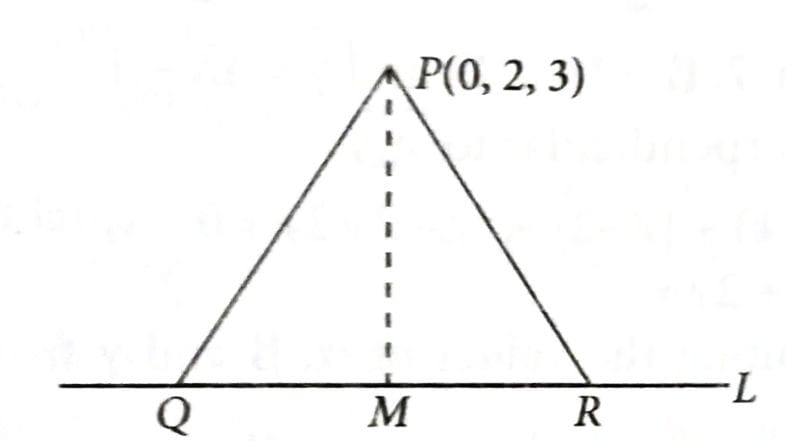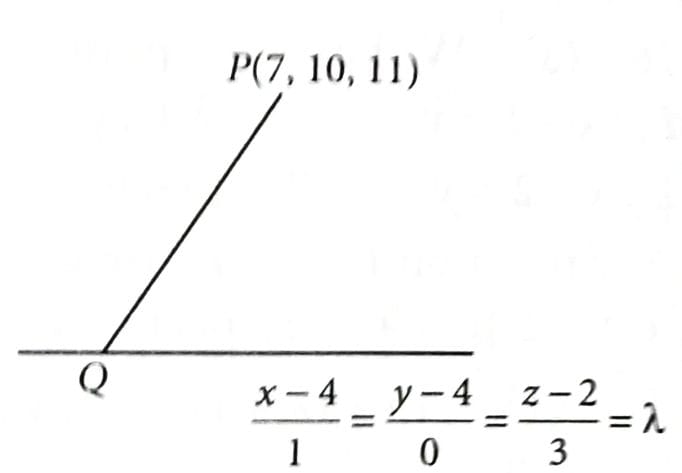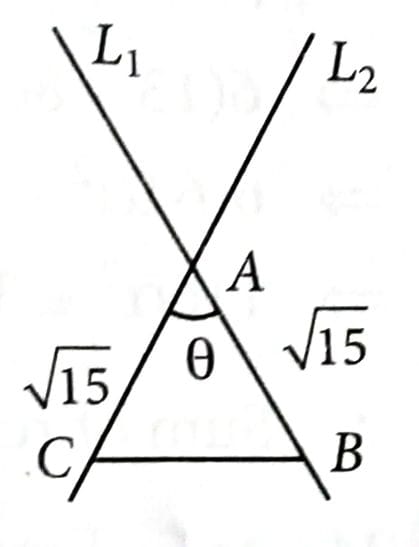Topic Question Set
Q 41
:
Let the vertices Q and R of the triangle PQR lie on the line , QR = 5 and the coordinates of the point P be (0, 2, 3). If the area of the triangle PQR is then: [2025]
(3)

We have, equation of line L is
Coordinates of
Dr's of PM are
Dr's of line L are < 5, 2, 3 >
As PM L, so,
Coordinates of M is (2, 3, –1)
Now,
Area of
.
Q 42
:
The line is parallel to the vector and passes through the point (7, 6, 2) and the line is parallel to the vector and passes through the point (5,3, 4). The shortest distance between the lines and is : [2025]
(1)
We have,
Here,
Now,
Also,
Shortest distance between and
Q 43
:
If the image of the point P(1, 0, 3) in the line joining the points A(4, 7, 1) and B(3, 5, 3) is , then is equal to : [2025]
18
-
-
-
(4)
Equation of line AB is given by
Any point on line AB is given by
Now, mid-point of PQ lies on AB i.e.,
is a point on AB
and
... (i)
Now, is perpendicular to
Now, substituting the values of , and from equation (i) we get
and
.
Q 44
:
Line passes through the point (1, 2, 3) and is parallel to z-axis. Line passes through the point (, 5, 6) and is parallel to y-axis. Let for , , the shortest distance between the two lines be 3. Then the square of the distance of the point from the line is [2025]
40
32
25
37
(3)
[ is parallel to z-axis and passing through (1, 2, 3)]
and
[ is parallel to y-axis and passing through ]
Now, shortest distance between and is given by
[]
Let the foot the perpendicular from point P(4, –2, 7) to the line is .
Direction ratios of the QP are (3, –4, 4 – )
QP is perpendicular to
So,
The coordinates of point Q are (1, 2, 7).
Q 45
:
Let a line passing through the point (4, 1, 0) intersect the line at the point and the line at the point B(a, b, c). Then is equal to [2025]
12
6
8
16
(3)
A(2t + 1, 3t + 2, 4t + 3) is any point on .
And is any point on .
D.R. of PA = 2t – 3, 3t + 1, 4t + 3 and D.R. of , where the coordinate of P is (4, 1, 0).
[Direction ratios of PA and PB are proportional]
... (i)
Also,
... (ii)
And
From equation (i), we get
... (iii)
From equation (ii), we get
... (iv)
From equation (iii) and (iv), we get
Now,
1(–1 + 3) – 0 + 1(–3 + 9) = 8.
Q 46
:
The distance of the point (7, 10, 11) from the line along the line is [2025]
14
18
16
12
(1)
Let

Any point on the line
has coordinates
i.e.,
Line PQ is parallel to line
Q(3, 4, –1) is the point on the line .
Hence, units.
Q 47
:
Let the shortest distance between the lines and be . Then the positive value of is [2025]
46
48
42
40
(1)
Given line are and
Let and
Now,
Shortest distance between lines
.
Q 48
:
Let A and B be two distinct points on the line . Both A and B are at a distance from the foot of perpendicular drawn from the point (1, 2, 3) on the line L. If O is the origin, then is equal to [2025]
49
62
21
47
(4)
We have,
Let foot of perpendicular from P(1, 2, 3) on L is
Now, []
Now, distance of A from Q(3, 5, 9) is the foot of perpendicular.
Let any point on line L is
Now, distance of A from Q is
are the points on the line L.
.
Q 49
:
Let A be the point of intersection of the lines and . Let B and C be the points on the lines and respectively such that . Then the square of the area of the triangle ABC is [2025]
57
54
63
60
(2)
We have, and

Angle between and ,
Now, area of
So, square of area = .
Q 50
:
Let the values of p, for which the shortest distance between the lines and is , be a, b, (a < b). Then the length of the latus rectum of the ellipse is : [2025]
9
-
18
-
(2)
We have lines
where,
Then,
Now, shortest distance
p = 3 and 1, then a = 1 and b = 3 ( a < b)
So, length of latus rectum of ellipse is .

